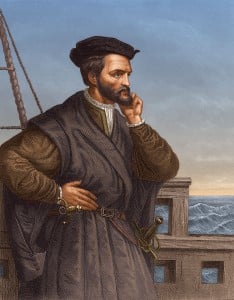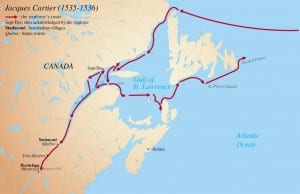Jacques Cartier (December 31, 1491 – September 1, 1557) was the first French Explorer to explore the New World. He explored what is now Canada and set the stage for the great explorer and navigator Samuel de Champlain to begin colonization of Canada.

Cartier was the first European to discover and create a map of the St. Lawrence River. The St. Lawrence River would play an important role in the New World during the French and Indian War, the American Revolutionary War, the War of 1812, and the colonization of America.
Jump to:
Early Life of Jacques Cartier
- Cartier was born in 1491 in Saint-Malo. During his early childhood, he would hear stories of the great Christopher Columbus, Vasco da Gama, and the exploits of the Spanish Conquistadors.
- His homeland, France, was relatively inactive in the exploits of the New World. Instead, it was embroiled in the European wars with the Holy Roman Empire, England, and Spain. Cartier grew and began to study navigation and, over time, became an excellent mariner.
- In a feudal society, talents were often overlooked and superseded by political standing. Cartier did not get the attention he deserved until he married Mary Catherine, who was a daughter in a wealthy and politically influential family.
First voyage, 1534

- In 1534, Jacques Cartier was brought to the court of King Francis I. King Francis I ruled France during the reign of Charles V in the Holy Roman Empire and Henry VIII of England.
- He was a talented Monarch and ambitious for great treasure. 10 years prior to Cartier, he had asked Giovanni da Verrazzano to explore the eastern coast of North America but had not formally commissioned him.
- Cartier set sail with a commission from King Francis I in 1534 with hopes of finding a pathway through the New World and into Asia.
- Jacques Cartier sailed across the ocean, landed around Newfoundland, and began exploring the area around the Gulf of the St. Lawrence River. While exploring, he came across two Indian tribes, the Mi'kmaq and the Iroquois. Initially, relations with the Iroquois were positive as he began to establish trade with them. However, Cartier then planted a large cross and claimed the land for the King of France.
- The Iroquois understood the implications and began to change their mood. In response, Cartier kidnapped two of the captain's sons. The Iroquois captain and Cartier agreed that the sons could be taken as long as they were returned with European goods to trade. Cartier then returned to his ships and began his voyage home. He believed that he had found the coast of Asia.
Second voyage, 1535–1536
- After his return from his first voyage, Cartier received much praise from Francis I and was granted another voyage, which he left the next year. He left France on May 19 with three ships, 110 men, and the two natives he promised to return to the Iroquois captain.
- This time, when he arrived at the St. Lawrence River, he sailed up the river in what he believed to be a pathway into Asia. He did not reach Asia but instead came into contact with Chief Donnacona, who ruled from the Iroquois capital, Stadacona.
- Cartier continued up the St. Lawrence, believing that it was the Northwest passage to the east. He came across the Iroquois city of Hochelaga and was not able to go much further. The St. Lawrence waters became rapids and were too harsh for ships.
- His expedition left Cartier unable to return to France before the coming of winter. He stayed among the people of Hochelaga and then sailed back to Stadacona around mid-October. He most likely set up winter camp here. During his encampment, scurvy broke out among the Iroquois and soon infected the European explorers. The prognosis was dim until the Iroquois revealed a remedy for scurvy. Bark from a white spruce boiled in water would rid them of the disease.
- Cartier and his men used an entire white spruce to concoct the remedy. The remedy would work and would save the expedition from failure.
- Cartier left Canada for France in May of 1536. Chief Donnacona traveled to France with him to tell King Francis of the great treasures to be found. Jacques Cartier arrived in France on July 15, 1536. His second voyage had made him a wealthy and affluent man.
Third voyage, 1541–1542
- Jacques Cartier's third voyage was a debacle. It began with King Francis commissioning Cartier to found a colony and then replacing Cartier with a friend of his, Huguenot explorer Roberval. Cartier was placed as Roberval's chief navigator. Cartier and Roberval left France in 1541.
- Upon reaching the St. Lawrence, Roverval waited for supplies and sent Cartier ahead to begin construction on the settlement. Cartier anchored at Stadacona and once again met with the Iroquois. While they greeted him with much happiness, Cartier did not like how many of them there were and chose to sail down the river a bit more to find a better spot to construct the settlement. He found the spot and began construction and named it Charlesbourg-Royal.
- After fortifying the settlement, Cartier set out to search for Saguenay. His search was again halted by winter, and the rapids of the Ottawa River forced him to return to Charlesbourg-Royal. Upon his arrival, he found out that the Iroquois Indians were no longer friendly to the Europeans. They attacked the settlement and left 35 of the settlers dead. Jacques Cartier believed that he had insufficient manpower to defend the settlement and search for the Saguenay Kingdom. He also believed that he and his men had found diamonds and gold and had stashed them on two ships.
- Cartier set sail for France in June of 1542. Along the way, he located Roberval and his ships along the coast of Newfoundland. Roberval insisted that Cartier stay and continue with him to the settlement and to help find the Kingdom of Saguenay, and Carter pretended to oblige. Cartier waited, and when the perfect night came, he and his ships full of diamonds and gold left Roberval and returned to France. Roberval continued to Charlesbourg-Royal but abandoned it 2 years later after harsh winters, disease, and the hostile Iroquois Indians.
- Upon returning to France, Cartier would learn that the diamonds he believed to have found were nothing more than mineral deposits. This ended the career of Jacques Cartier.
Later Life and Death
- Jacques Cartier retired to Sain-Malo, where he served as an interpreter of the Portuguese language. A typhus epidemic broke out in 1557 and claimed the life of the great explorer. Cartier died 15 years after his last voyage to the New World.
- While Cartier's missions did not establish a permanent settlement in Canada, it laid the foundation for Samuel de Champlain.
